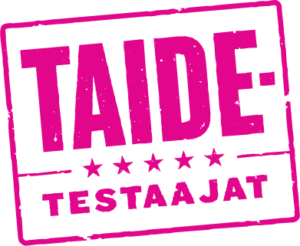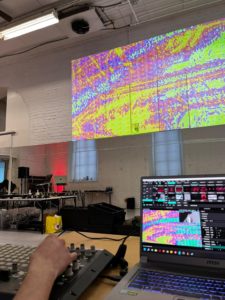author: Carita Rukakoski, Humak University of Applied Sciences
I interviewed Aleksi Valta, executive director of the Association of Finnish Children’s Cultural Centers, and Auni Tuovinen, art educator and developer of inclusion at the cultural center ARX in Hämeenlinna, for the Diggiloo project. Here is a small introduction to the activities of the umbrella organization and one of its member organizations, as well as the opinions of both interviewees on the current state of cultural activities for children and young people and its development opportunities.
The Children’s Cultural Center is a national association, an umbrella organization of organizations. Through the association, people can get an overview of what is happening in the field of children’s culture by the members. “We do a lot of projects together with the members, and the biggest of all is the Art Testers program, where the digital side has been strongly present. It is the largest art project for young people in the history of Finland, where all of Finland’s eighth graders are taken to art. During the pandemic, the program produced a lot of digital content for eighth graders. Their success and popularity varied,” says Aleksi. The association has also established the website harrastakotona.fi , which offers ideas and tips that children and young people can be inspired to make art at home as well.

Picture: Art testers website.
The starting point and operation of the Children’s Cultural Center is based on Article 31 of the UN Convention on Human Rights on children’s rights. “We want to promote children’s right to culture, hobbies and art,” says Aleksi. “Our network differs from basic art education, for example, in that basic art education is in accordance with the curriculum and is aimed only at the few and selected, while our activities are aimed at those others for whom there is not so much to offer. Promoting cultural education plans is really important to us as a union and as a network.” he continues.
Auni, who works at the multidisciplinary open Kulttuurikeskus ARX in Hämeenlinna, says that children of all ages and their families, as well as youth, participate in their activities. The center’s activities are extremely versatile. Auni lists that their services include e.g. exhibition activities, guided tours for schoolchildren and early childhood education groups, open art mornings for families, family club for immigrants, Tuu ja tee! -afternoon art club for schoolchildren as well as various events, such as ARXantai events for families with children, the Hippalot art festival, the light art event Valoilmiö, and content related to youth culture, such as the street art festival Räikee, which is carried out under the separate HÄX brand. “The central value of our operation and the object of continuous development is the quality of children’s culture and increasing inclusion,” says Auni.
“One of HÄX’s most recent projects has been, for example, the Demo tour, which is done in cooperation with the HIL – Hobby close by -project (suom. “Harrastus ihan lähellä”), which is part of the Finnish model of hobby. In the Demo Tour, all the middle schools in Hämeenlinna have been visited and workshops have been offered to all the school’s students. In workshops they can try different areas of youth culture. On Demo Tour students have tried e.g. graffiti painting with VR glasses, different ways of making machine music with tablets and other machine music devices,” continues Auni enthusiastically.
ARX’s activities are not limited to any specific type of art, but the offer ranges from fine art to crafts and crafts, from light art to media art and media education, and all the way to various subgenres of youth culture such as graffiti painting and rap and hip-hop. When there is a lot of everything to try, you never know what you might get excited about (author’s note).

Picture: Artcenter Arx website.
“Community art is a community- or participant-oriented art activity where community members can participate in the art process in its various stages.” (Auni Tuovinen)
Sometimes the path to the world of culture can be opened by accident. This seems to have happened to Auni as well. Her own journey into culture started as a child with music and acting. After high school, she became interested in manual skills and she studied to be a seamstress. During an internship at a workshop for the unemployed, she realized that it would be nice to work with culture in the role of a instructor. Enthusiastic about the idea, she applied to a university of applied sciences to study as an art expert in guidance activities and ended up working with children’s culture through that. Since then, she started studying art education at the university to improve her professional skills.
Aleksi’s path to the children’s cultural art has also started somewhat unintentionally and without purpose. He worked for years in sports organizations, but when the right opportunity came, he jumped into a world, that was a little strange to him, but he has enjoyed it.
Children and young people can be a challenging target group to attract to an activity, whatever it may be, but especially cultural and artistic activities, which can have a slightly strange echo in the ears of young people. When asked from the interviewees where and how they try to reach children and young people, the answer is the same for both: investigative “youth work” and investigative cultural work. You have to go where the young people are and offer services there. Auni gives skate parks, youth events and of course schools as examples.

Picture: harrastakotona.fi
Just a week after the interview, Aleksi Valta was participating in the children’s culture forum, which theme was participation and its best practices. So work is really being done to reach young people and involve them. “Young people need to be given time and persistently continue to organize events and happenings, even those no one is likely to come to at first”, explains Auni. “The biggest challenge in the hobby model in Finland is that there is limited amount of successful experiments with upper comprehensive schoolers. It’s a difficult target group that requires specific expertise to work with.”, Aleksi opens the matter.
“The performing arts do not necessarily work for children and young people digitally, and not really for the rest of the public either. Why would you want to virtually watch a theatrical performance that may not be so well filmed, or the sound quality is poor, when at the same time you can watch a world-class movie that was made for that purpose via the screen.” (Aleksi Valta)
Finally, when I ask both what they think about the state of cultural art for children and young people at the moment and if there is perhaps something they would like to develop in the field, both end up with the same result in their answer: funding and resources. And mostly to the lack of them. “The whole thing is too project-like, which is highlighted in what we do. The umbrella organization’s funding is entirely dependent on grants. For example, on the side of sports organizations, operations and funding are much more long-term. It’s a bit sad. Such a rush of projects all the time is really exhausting and the constant fundraising takes the focus away from the important youth work itself, that’s a problem.” says Aleksi. “So the challenge and problem is that when there are few staff, the work inputs go to the administration.” he continues.
However, Auni thinks that children’s culture centers have a lot of expertise and methods of operation related to the participation of children and young people. “It could be used more broadly in different areas of society, e.g. when you want to know the wishes and thoughts of children and young people.” she suggests.
“Part of the performing arts, e.g. musical performances work a little better, but they also have the problem that they are intended as an interactive event in the program. There were very successful stories, for example, in word art workshops, where schoolchildren participated via chat.”
(Aleksi Valta, about the experiences of the Norwegian Den kulturelle skolesekken [The Cultural Rucksack] program during the corona period)
Interviewer: Carita Rukakoski
Interviewees: Aleksi Valta, executive director, Finnish Association of Children’s Cultural Centers; Auni Tuovinen, art educator, development of inclusion, Culture center ARX
Interviews conducted: 11/2022 verbally and in writing








